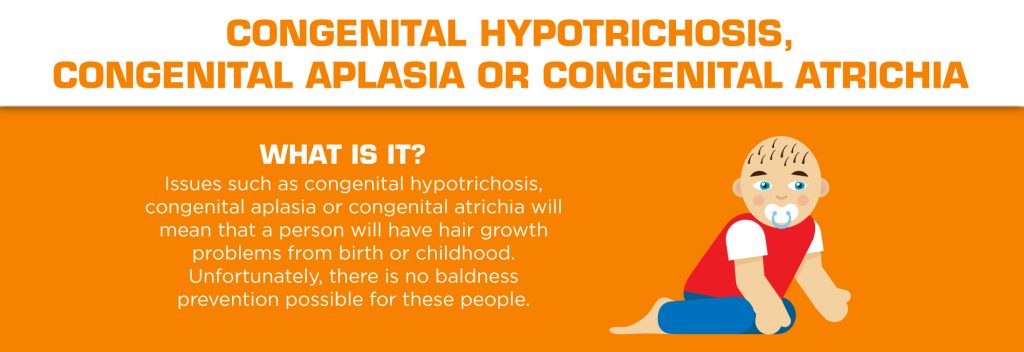CONTENTS

Years before they have serious reasons to worry about losing hair, men worry about it anyway. After all, the two most visible signs of a man’s youth and virility are their physique and their hair. They can work out regularly to maintain their fitness and muscle strength even as they age, but baldness is largely out of their control – and by the age of 30, half of all men discover some of their hair coming out.
How serious a blow is that to a man’s confidence and ego? A Spanish study found that nearly two-thirds of balding men linked their hair loss to their self-esteem. And since “hair loss age” can begin well below 30 for some males, hair loss in young men can be the worst blow of all.
What causes baldness in men? There are many different reasons, so there’s no simple way to make sure you won’t start losing your hair as you grow older.
And every time you see a bald man – whether it’s your father, a relative, a friend or just a ridiculous-looking guy with a comb-over driving a convertible – you “know” in the back of your mind that you could be next. Sure, you can take vitamins and eat properly, but if you’re destined by genetic makeup to have a hair loss problem, those precautions probably aren’t going to make a big difference in the long run.
What’s going to be much more important is what you do once you start seeing hair dropping from your head.
Types and Causes of Hair Loss
There are many different types and causes of baldness. Let’s take a closer look at what can be the cause of hair loss in men, and then check out some of the most effective types of men’s hair loss treatments currently available.
Androgenetic Alopecia (AGA) or Male Pattern Baldness (MPB)
To start our discussion of hair loss reasons for male patients, let’s talk about a term that’s often heard when discussing balding in men: alopecia. Some people believe that’s a specific type of hair loss condition or disease, but it’s really just the medical term that is used to describe all types of hair loss.
The issue most often referred to when people use the word alopecia is better described as androgenetic alopecia (AGA), popularly known as male pattern baldness (MPB) – the most common type of hair loss experienced by men. The specific cause of AGA is not known, but it’s definitely a function of heredity and male hormones. Some researchers believe it has to do with high amounts of the protein prostaglandin D2. In any event, it happens when hair follicles in the scalp shrink and produce thinner, shorter hairs, and eventually stop producing new hair.
Male pattern baldness usually begins at the edge of a man’s hairline; as the hairline recedes the remaining hair first forms the shape of an “M” on the scalp, and then a “U” around the sides of the scalp. According to WebMD, AGA is so common that it affects four-fifths of all men under the age of 70. The good news is that the follicles never actually die, which is why some hair treatments for hair loss are able to work their magic.
That doesn’t mean there’s an actual male pattern baldness “cure,” but that it can be treated.

Telogen Effluvium (TE)
While male pattern baldness is the type of hair fall in men most often seen, there are many others. The second-most-common is known as telogen effluvium (TE), which occurs when a much smaller number of hair follicles than usual are producing hair. This hair loss normally doesn’t show in a pattern or as complete baldness, but rather as a thinning of hair in areas across the scalp. Sometimes the thinning is even, but there can also be areas more severely affected than others.
There’s an important difference between AGA/MPB and TE; in pattern baldness, the follicles have stopped producing hair completely, while in telogen effluvium the follicles are just in an extended “resting” state. That’s important because TE is usually caused by one of three problems: – A sudden shock to the body, such as being in a serious accident, surgery or crash dieting – Some types of medications, notably antidepressants – Chronic stress or illness, or vitamin, mineral or amino deficiencies due to poor diet |

Cancer and Anagen Effluvium
It is extremely common for cancer patients to lose their hair, and that is due to a process similar to TE known as anagen effluvium. Anti-cancer drugs are responsible for the “shock” to the body causing hair fall, but the medications work so quickly to stop cell growth that follicles don’t have enough time to go into a resting state. Instead, they enter a state similar to suspended animation and the patient’s hair falls out rapidly – and often, completely. Within a month of the drug treatment’s completion, hair growth resumes. But at times the type of hair produced may have changed. For example, curly hair may become straight or the patient’s “normal” hair color may be permanently different.

Alopecia Areata (AA)
Around one out of every fifty people will develop another form of hair loss, alopecia areata (AA), during their lifetime. AA is apparently caused by an auto-immune disease which attacks a person’s hair follicles, causing inflammation and preventing hair growth.
It manifests most often as bald circular patches on the head, usually just a few of them. However, it can also affect the entire scalp (alopecia totalis), the entire body (alopecia universalis) or just a man’s beard (alopecia barbae).
A similar problem is traction alopecia, caused when people wear hairstyles like braids or cornrows which pull tightly or apply pressure to hair.
Often people with only one or two bald patches will find that the follicle inflammation (which isn’t visible on the scalp) subsides or even vanishes on its own and hair growth resumes. In about one-third of patients, however, the problem is a persistent one and can worsen. The cause of AA is uncertain; it was once believed to be the best example linking hair loss and stress, but most experts now believe there are several factors involved including genetics, viruses and/or environmental factors.

Scarring Alopecia
A number of other types of hair loss seen less frequently in the developed world are still common enough to merit mention in this discussion.
Scarring alopecia is an umbrella term for many of them (including folliculitis decalvans, dissecting cellulitis and lichen planopilaris) and they all present with similar symptoms: ragged bald patches which often grow in size over time. Visual diagnosis of these conditions is difficult because symptoms can vary widely, with some patients suffering redness or discoloration, scaly skin, itching or pain – and others suffering none of those problems. What they have in common, however (other than the bald patches) is that the follicles are destroyed below the surface of the scalp, so new hair growth is not possible; medications for hair loss don’t work for these patients, and a specialist usually has to diagnose these conditions.
Scarring alopecia can also be a byproduct of a disease such as chronic lupus.

Congenital Hypotrichosis, Congenital Aplasia or Congenital Atrichia
Issues such as congenital hypotrichosis, congenital aplasia or congenital atrichia will mean that a person will have hair growth problems from birth or childhood. While these are serious problems (usually genetically-based) which can lead to lifelong baldness in men, they don’t rigorously fall into the traditional categories of male hair loss. Unfortunately, there is no baldness prevention possible for these people.

Can Baldness Be Prevented?
So what causes hair loss in men can vary widely, but the important question for most readers isn’t why men lose hair.
It’s whether it can be avoided or cured.
Let’s move on from the causes of hair loss, to examine issues like hair loss prevention products, medical treatment for hair loss, and hair replacement therapy.
Prevention is Better than Cure
We’ve already mentioned that if you’re pre-destined by genetics to lose your hair, there’s probably not much you can do about it. However, there are definitely steps you can take to at least delay the inevitable, and some experts claim that they’re even more effective than that: true, natural hair loss prevention solutions.
Diet and Hair Loss Prevention
The most common suggestions involve diet. Avoiding fried foods and sugary desserts (as much as possible, of course – who could live without French fries or ice cream?) is said to reduce the conversion of male testosterone to a substance known as DHT – and sensitivity to DHT is what causes the hair loss issues associated with male pattern baldness. It’s all part of practices to help people have healthier hair and skin.

Supplements and Hair Loss Avoidance
Related steps you can take for the prevention of hair fall involve vitamins and minerals, whether you get them through the foods you eat or via supplements. Vitamin A (contained in many fruits and vegetables) can help promote healthy scalp tissue and hair; B-vitamins including B6 and B12 (found in most proteins) help the body create and carry healthy, oxygenated blood to the scalp; and Vitamin C (in sources like oranges and leafy green vegetables) is required to produce the collagen needed to hold hair tissues together. Drinking plenty of water helps, too.

Hair Loss Shampoos Anyone?
There’s one more thing you can do to try to delay the onset of baldness, and that’s to try a hair loss shampoo for men. Several research projects have found that an antifungal substance used to battle dandruff called ketoconazole works by cutting the amount of testosterone in hair follicles, so there’s less of the hormone to be converted into problem DHT. You can get prescription shampoos with ketoconazole if you have a severe dandruff problem, but there’s one non-prescription product called Nizoral A-D which also contains the antifungal and might help with alopecia prevention, even though it’s not sold as an actual hair restoration shampoo.

Groom+Style for art of hair have written another article which talks about different ways you can focus on keeping the hair you have healthy.
Hair Loss Remedies for Men
Now that you know all about the physical and medical reasons for hair loss and what you might be able to do to prevent it, it’s time to turn to the most important question for people who’ve lost hair: baldness remedies and treatments for hair growth.
It’s important to realize that not all solutions will work for all men’s hair fall. Their effectiveness depends on both an individual’s specific hair loss causes and how their body reacts to the treatments. Consulting a dermatologist or other medical specialist is often the best route to take before choosing from the many hair loss solutions for men on the market, and of seeing a doctor is necessary if you’re considering a surgical hair transplant.
With that in mind – here we go, probing deeper into the world of falling hair: procedures and products for hair loss and thinning hair, including herbal treatment for hair loss, medicine for baldness, procedures using laser and hair transplant surgery.
Is There A Natural Cure for Hair Loss?
It depends on who you ask; some say that hair loss natural treatment is the safest approach. Integrative medical specialist Dr. Andrew Weil suggests including generous amounts of Omega-3 fatty acids in your regular diet or getting them through supplements. His recommended fatty acid sources are wild Alaskan salmon, mackerel, sardines or herring eaten several times per week, adding walnuts to your diet, or sprinkling flaxseeds (freshly ground) onto your salads.
He also says that gamma-linolenic acid (GLA), found in evening primrose oil or black currant oil supplements, may help as well. Others, including “healing herb” expert Dr. James A. Duke, claim that saw palmetto is worth trying for androgenetic alopecia since it does much the same thing as the baldness drug Propecia, stopping testosterone from being converted to DHT.
There’s no shortage of “guaranteed” hair loss natural remedies, particularly if you suffer from alopecia areata. Some are handed down through families, others come from hair loss sufferers who swear by their discoveries, and some have their origins in ancient cultures.

They range from rubbing lavender or onion juice into the scalp, to regularly taking licorice root or fenugreek. Will a natural or herbal remedy for hair loss work? Medical experts say they don’t – and that if they did, we’d certainly all know about them and be using them by now. On the other hand, proponents swear by their personal hair loss home treatment. Many suffering from hair fall are understandably willing to give almost anything a try and there’s certainly no harm in testing salmon, walnuts or onion juice as long-shot cures for baldness. |
Hair Loss Oil and Hair Loss Spray
Closely related to natural remedies are oils and sprays which are said by proponents to be an effective men’s hair loss treatment. One suggestion often heard from holistic home practitioners is to rub castor oil on hair; they claim that that ricinoleic acid in the oil can stimulate or speed hair growth because it boosts blood circulation to the scalp while balancing its pH. There’s a link between vitamins and hair loss according to many naturopaths; some possibilities to consider are sweet almond oil, which has vitamins D and E to moisturize the hair and scalp, keep them healthy and promote growth; and virgin olive oil, which does much the same thanks to vitamin E and fatty acids.
There are several sprays on the market which claim to be able to strengthen individual strands of hair for people suffering from hair loss (more of a thinning hair remedy than a growth solution), and others which use some of the ingredients we have already mentioned (often relying on vitamins to prevent hair loss) but in spray form.
There’s no real proof that any of them are effective, and some which promise to “unclog blocked follicles” are actually banned by the Food and Drug Administration. The more common sprays you can buy are concealers designed to cover up bald spots by either adding particles to your scalp which match the color of your hair, or to coat existing strands of hair and then “spread them out” to make your hair look fuller and hide any bald spots.

Do the oils and sprays work? Once again, medical experts say the treatments intended to regrow hair or prevent hair fall in men really don’t, while many users swear that they do. The only thing most people can agree on is that spray painting your head, whether it’s with a “concealer” or with (hopefully non-toxic) spray paint, can make bald spots less visible. That’s certainly not a way of preventing baldness or a new hair regrowth treatment, but at least it’s a method to provide a small ego boost for some men. |
Medicines for Hair Loss
We now reach the category of men’s hair restoration treatments which medical specialists say do work for androgenetic alopecia hair regrowth: prescription drugs for men’s baldness.
Propecia and Rogaine have each proven to be an effective medicine for hair fall over long periods of time, and are now the major hair loss medical treatment recommended by dermatologists.
Understanding the Drug Propecia
We’ve talked several times about the role that testosterone and DHT play in the thinning of men’s hair and eventual baldness. The real key to medical hair loss treatment is a drug called finasteride, which is sold to consumers under the name Propecia and taken orally. What this hair fall medicine does is block the conversion of testosterone to the real villain in hair loss, DHT, by as much as 70 percent. In the majority of cases, it takes anywhere from three to twelve months for the process to work effectively to stop hair fall; it often can stimulate the growth of new hair as well.
There are several things to consider before using Propecia, however. The first is that you will probably have to use it forever because most men who stop Propecia treatment see their new hair falling out again. The second is that depression and sexual side effects, including erectile dysfunction, are often a byproduct of taking the drug. Finasteride is also available as a generic medication and under the brand name Proscar, although Proscar is usually prescribed for prostate problems because it is higher-strength than Propecia.

Understanding the Drug Rogaine
Another drug for hair loss considered by many men is the topical solution minoxidil, marketed under the brand name Rogaine. A common misconception is that minoxidil is similar to finasteride – but that couldn’t be further from the truth. Minoxidil does something completely different; it is a vasodilator, which is used to widen blood vessels.
On the scalp, it makes hair follicles wider and hair thicker, and increases the “lifespan” of hair production in the follicles. However, it doesn’t do anything about the DHT problem so usually there’s no hair regrowth seen. For that reason only about a third of men are able to slow down hair loss just by using Rogaine, and only about 10% grow new hair. The effects also disappear when patients stop using the drug.

A Combination of Finasteride (Propecia) and Minoxidil (Rogaine)
What works best is combining the hair growth medicine finasteride with minoxidil. The latter “fertilizes” the area while the former works to prevent hair fall and grow new hair. This combination is the best non-surgical way to deal with male pattern baldness and is most often prescribed by medical professionals.

Hair Transplants
Surgical hair transplants have come a long way in the last thirty years. Doctors used to graft ugly hair plugs into the scalp – and that’s how they looked, ugly.
Today, male hair replacement done by experts has become almost an art.
When performing a hair transplant on men, doctors harvest individual hair follicles from “donor areas” in areas which are not affected by DHT and are largely unseen, such as behind the ear, and carefully plant them in areas where the patient’s hair is thinning or has fallen out. Each follicle has only a few hairs, so it is a long and laborious process; however, skilled physicians are able to create a natural-looking “hairscape” which will last. Transplants are easiest to perform as a frontal hair loss treatment but can be done even for men whose baldness has progressed much further.

There are several drawbacks to hair loss surgery, both of which are probably obvious. Since the hair replacement treatment process is such a painstaking one, it takes a long time. Most procedures require an entire day (or close to it) of transplantation work. An even bigger issue for many patients is the cost of hair transplants. A full hair loss transplant procedure by a skilled doctor can cost $5,000, $10,000, $15,000 or even more depending on how much hair the patient has lost and the availability of donor areas – and the process is almost never covered by medical insurance. Is there such a thing as an affordable hair transplant? It depends on your definition of “affordable,” but you usually get what you pay for.
However, most patients say a hair transplant’s cost is worth it. The hair usually lasts a lifetime and looks completely natural when the transplant is performed properly.
Laser Hair Restoration
A somewhat-controversial alternative to surgery has emerged over the last decade: laser hair restoration, also known as low laser light therapy (LLLT). The idea for this hair regeneration treatment actually sprang from observations made when lasers were used for hair removal. When not enough energy was used to power the laser the hair actually appeared to grow, instead of dying. That led to the use of low-powered lasers to supposedly repair damaged cells in follicles and stimulate the regrowth of hair.
Many doctors now have practices specializing in laser therapy for hair loss, a long and tedious process for the patient involving sessions twice a week for as long as six months and costing somewhere in the vicinity of $4000.
As you would expect, professionals performing the process claim great success rates, but most medical experts say there’s very little evidence that hair loss laser treatment actually works to any great degree.

Those wishing to try LLLT can actually do it at home with a device known as the hair loss “laser comb,” which sells for $300 to $500. It is used three times per week over a long period of time, and only emits low-levels of radiation so the FDA has approved the device for safety. The agency hasn’t approved it for efficacy, however, meaning claims that home laser hair growth treatment is effective are largely anecdotal or driven by those selling the combs.
Hair Loss Conclusions
Cavemen probably resorted to putting leaves on their heads when they started seeing loss of hair on the head – in what would be prehistoric precursors to the hideous toupees bald men often wore in later years – since most people suffering hair loss, man or woman, can be traumatized by the experience.
Today’s alternatives aren’t always perfect, but many are proven and effective solutions to the problem of male hair loss. What’s the best product for hair loss? It all depends on the reason for hair loss and how your body responds. The best hair loss solution is the one that works for you.
Continue reading via this link if you are interested in Groom+Style’s list of top 10 hair care products for man categorized by hair type.




do you think using the Laser Caps for Hair Growth is a good alternative as compared to hair transplant?
Hi Francis,
We are not honestly sure about the science behind laser caps, this is something our readers will have to do their own research on.
For those interested in knowing what laser caps are here is an example link to one such product on Amazon -> https://geni.us/lasercapshairgrowth
Kind Regards,
Pierce